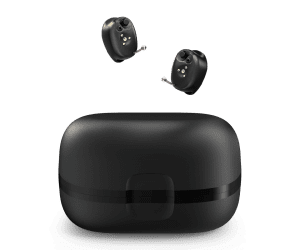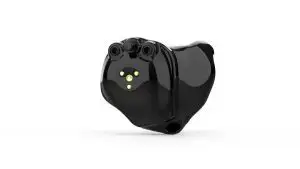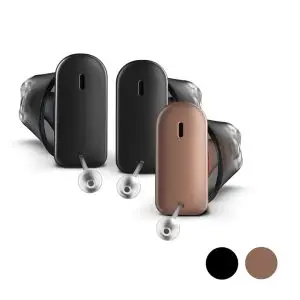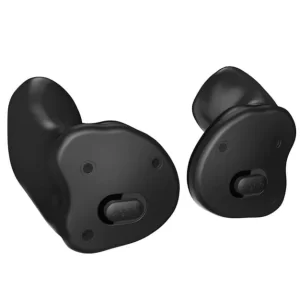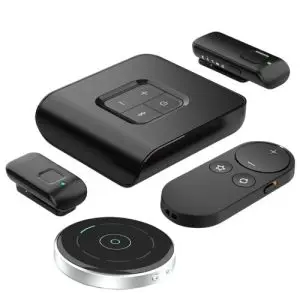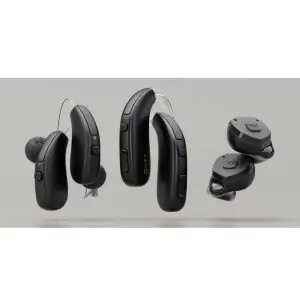Understanding Custom Hearing Aids
Hearing aid manufacturers specially design custom hearing aids to fit the unique contours of an individual’s ear. These devices are crafted based on ear impressions taken by an audiologist. Therefore, ensuring a personalized fit that can offer enhanced comfort and performance. Custom hearing aids come in various styles, including In-the-Ear (ITE), In-the-Canal (ITC), Completely-in-the-Canal (CIC), and Invisible-in-the-Canal (IIC).
Custom hearing aids come in various styles to cater to different preferences and needs. In-the-Ear (ITE) hearing aids fill the outer portion of the ear, providing a secure and comfortable fit. In-the-Canal (ITC) hearing aids are smaller and sit partly in the ear canal, making them less visible. Completely-in-the-Canal (CIC) hearing aids fit deeper into the ear canal, offering an even more discreet option. The most inconspicuous are Invisible-in-the-Canal (IIC) hearing aids. These are almost entirely hidden within the ear canal, providing maximum discretion and a natural appearance.
Standard Fit Over-the-Counter (OTC) Hearing Aids: Designed to be Self-Fit and Fit the Majority of Ear Shapes.
A standard fitting OTC hearing aid is an off-the-shelf device that fits the general shape and size of most people’s ears without requiring custom molds or extensive adjustments. These hearing aids are typically more accessible and quicker to obtain than custom hearing aids, as they do not require the process of taking ear impressions and manufacturing personalized devices.
Features of Standard Fitting Hearing Aids:
- Universal Fit: Designed to accommodate a wide range of ear shapes and sizes with adjustable components, such as soft silicone domes or generic earmolds, to ensure a comfortable fit for most users.
- Immediate Availability: Can be purchased directly from hearing aid providers, online retailers, or even over-the-counter, making them a convenient option for those needing quick solutions.
- Adjustability: Equipped with user-friendly controls for adjusting volume and program settings to suit different hearing environments. Some models also connect to smartphone apps for additional customization.
- Versatility: Suitable for various levels of hearing loss, from mild to moderate, depending on the model and features.
- Cost-Effective: Generally less expensive than custom hearing aids due to mass production and lack of need for personalized fitting services.
- Self-Fitting: Users adjust these devices themselves without the need for professional fitting.
Manufacturers create self-fitting hearing aids to allow users to adjust and fine-tune their devices without professional assistance.
Here are some examples:
These hearing aids are designed for self-fitting and can be adjusted using the Jabra Enhance app. Users can control the settings to match their hearing preferences and needs. These are an earbud style, rechargeable, and offer Bluetooth audio and phone call streaming.
HP Hearing Pro OTC hearing aids are designed for mild to moderate hearing loss and come with a mobile app, the HP Hearing App, that allows users to customize the settings. They are also an earbud style, rechargeable, and offer streaming options.
Lucid have also made these hearing aids for self-fitting and adjusting through the Lucid Hearing App. They offer four programs that users can personalize based on their hearing needs. These are rechargeable, nearly invisible, and do not offer any streaming.
LINNER provides a range of OTC hearing aids, including the Nova and Mars models, which can be self-fitted using the LINNER app. These are more basic technology and fit more like earbuds or AirPods.
- Sony CRE-E10 and CRE-C10:
Sony has two self-fitting ITE models. Each are set up through the Sony Hearing Control App. Users take an online hearing test and adjust the hearing aids themselves based on the results. The CRE-E10 is more like an ear-bud style, is rechargeable and allows for Bluetooth streaming. The CRE-C10 model on the other hand is smaller, invisible in the ear, uses a size 10 battery, and has no streaming features.
These self-fitting hearing aids provide greater autonomy and convenience, allowing users to personalize their hearing experience according to their specific needs.
Professionally-Fit Prescription Custom Hearing Aids
A hearing healthcare professional programs custom hearing aids to fit your hearing loss based on your hearing test, and these aids are available by prescription only. Hearing care providers take ear impressions to make these hearing aids.. Your provider then send the ear impressions to the hearing aid manufacturer so they can create prescription hearing aids that perfectly fit your ears. Custom fit hearing aids can come in both rechargeable and battery powered options. These days some are even equipped with Bluetooth connectivity.
Features of Prescription Fit Custom Hearing Aids:
- Sound Amplification: Enhances sound frequencies based on individual hearing loss profile.
- Custom Fit: Tailored to the unique shape of your ear canal for maximum comfort and secure fit.
- Sound Amplification: Enhances sound frequencies based on individual hearing loss profile.
- Noise Reduction: Reduces background noise for clearer sound in various environments.
- Feedback Cancellation: Minimizes or eliminates whistling and feedback sounds.
- Directional Microphones: Focuses on sounds in front of the user while reducing sounds from other directions.
- Multiple Listening Programs: Different settings for various listening environments (e.g., quiet, noisy, music).
- Automatic Adjustments: Adapts automatically to different sound environments.
- Speech Enhancement: Improves clarity of speech.
Here are some examples:
These hearing aids were the first rechargeable, streaming-capable custom hearing aid on the market. They are a bit larger and are an ear-bud style.
Similar to the Signia custom option, these are also an ear-bud style and offer rechargeability as well as direct streaming.
Another ear-bud style option. Available in both rechargeable and battery options. Rechargeable options offer audio streaming.
Widex offers a range of size options for their custom hearing aids. From invisble CIC (completely-in-the-canal) to ITE (in-the-ear half shell) for more power, they have options for differing hearing losses and needs. These use batteries and do not allow for any streaming.
These new hearing aids by Starkey are the smallest rechargeable custom hearing aids on the market. They are also offered in even smaller battery powered options as well.
Differences Between Custom and Non-Custom/BTE Hearing Aids
1. Fit and Comfort:
- Custom: Tailored to the individual’s ear shape, providing a more comfortable and secure fit.
- Non-Custom/BTE: May require adjustments and can sometimes feel less secure.
2. Appearance:
- Custom: Generally less visible, especially styles like CIC and IIC.
- Non-Custom/BTE: More visible due to their placement behind the ear.
3. Performance:
- Custom: Better for individuals with mild to moderate hearing loss and can offer improved sound localization.
- Non-Custom/BTE: Can suit any level of hearing loss due to more varied options for power.
Custom Hearing Aids and Occlusion
Custom hearing aids, tailored to fit the unique shape of an individual’s ear, have the potential to occlude the ear canal more effectively than non-custom options. This occlusion can enhance sound quality by preventing sound leakage and reducing background noise, making them particularly beneficial for individuals with mild to moderate hearing loss. Moreover, hearing aid manufacturers can custom-design custom hearing aids to fill larger ear canals more precisely, ensuring a snug fit that standard-sized hearing aids might not achieve. This tailored fit can significantly improve comfort and acoustic performance, providing a more effective hearing solution for users with larger ear canals or specific hearing needs.
Occlusion Explained:
Maintenance
Their intricate design and smaller components, tailored to fit the unique contours of an individual’s ear, make custom hearing aids harder to clean and maintain. Their compact size and deeper placement in the ear canal make them more susceptible to earwax buildup and moisture exposure, complicating routine cleaning tasks. Unlike standard or behind-the-ear models, which often have larger and more accessible parts, custom hearing aids require specialized tools and techniques for proper maintenance.
Battery Life
Custom hearing aids typically use small zinc-air batteries, which activate upon exposure to air and provide a reliable power source. These batteries come in various sizes, such as 10, 312, and 13, depending on the hearing aid model. Recently, rechargeable options have become increasingly popular, offering greater convenience and environmental benefits. Many custom hearing aids now feature rechargeable lithium-ion batteries, which provide long-lasting power and eliminate the need for frequent battery replacements.
Brands like Starkey, Signia, Horizon, and Rexton have embraced this technology, offering custom hearing aids with built-in rechargeable batteries that can last an entire day on a single charge. These rechargeable models often come with easy-to-use charging stations, making them a practical choice for users seeking both convenience and sustainability.
Pros and Cons of Custom Hearing Aids
Pros:
- Comfort: Custom-made to fit the ear precisely, which can lead to better comfort and less irritation.
- Aesthetics: Can be less visible, offering a more discreet hearing solution.
Cons:
- Cost: Generally more expensive due to the custom manufacturing process.
- Durability: Smaller size can make them more susceptible to damage.
- Maintenance: Again, harder to clean and maintain because of their small components.
Conclusion
Custom hearing aids offer a personalized fit and can be more comfortable and discreet than non-custom or BTE hearing aids. However, they come with higher costs and require more careful maintenance. When choosing the right hearing aid, it is essential to consider individual hearing needs, lifestyle, and preferences. Consulting with an audiologist, like Kim Fishman at Hears to U in Hopkins, Minnesota, can help ensure you select the best option for your hearing health.


